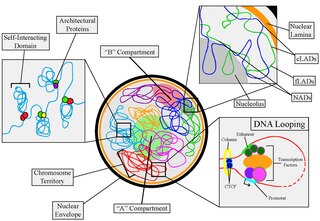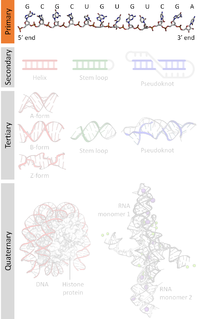
Genetics is a branch of biology concerned with the study of genes, genetic variation, and heredity in organisms.

In the fields of molecular biology and genetics, a genome is the genetic material of an organism. It consists of DNA. The genome includes both the genes and the noncoding DNA, as well as mitochondrial DNA and chloroplast DNA. The study of the genome is called genomics.

The human genome is the complete set of nucleic acid sequences for humans, encoded as DNA within the 23 chromosome pairs in cell nuclei and in a small DNA molecule found within individual mitochondria. These are usually treated separately as the nuclear genome, and the mitochondrial genome. Human genomes include both protein-coding DNA genes and noncoding DNA. Haploid human genomes, which are contained in germ cells consist of three billion DNA base pairs, while diploid genomes have twice the DNA content. While there are significant differences among the genomes of human individuals, these are considerably smaller than the differences between humans and their closest living relatives, the chimpanzees and bonobos.

Molecular evolution is the process of change in the sequence composition of cellular molecules such as DNA, RNA, and proteins across generations. The field of molecular evolution uses principles of evolutionary biology and population genetics to explain patterns in these changes. Major topics in molecular evolution concern the rates and impacts of single nucleotide changes, neutral evolution vs. natural selection, origins of new genes, the genetic nature of complex traits, the genetic basis of speciation, evolution of development, and ways that evolutionary forces influence genomic and phenotypic changes.

The Y chromosome is one of two sex chromosomes (allosomes) in mammals, including humans, and many other animals. The other is the X chromosome. Y is normally the sex-determining chromosome in many species, since it is the presence or absence of Y that typically determines the male or female sex of offspring produced in sexual reproduction. In mammals, the Y chromosome contains the gene SRY, which by typical default triggers testis development. The DNA in the human Y chromosome is composed of about 59 million base pairs. The Y chromosome is passed only from father to son. With a 30% difference between humans and chimpanzees, the Y chromosome is one of the fastest-evolving parts of the human genome. To date, over 200 Y-linked genes have been identified. All Y-linked genes are expressed and hemizygous except in the cases of aneuploidy such as XYY syndrome or XXYY syndrome.
C-value is the amount, in picograms, of DNA contained within a haploid nucleus or one half the amount in a diploid somatic cell of a eukaryotic organism. In some cases, the terms C-value and genome size are used interchangeably; however, in polyploids the C-value may represent two or more genomes contained within the same nucleus. Greilhuber et al. have suggested some new layers of terminology and associated abbreviations to clarify this issue, but these somewhat complex additions are yet to be used by other authors.

The Chimpanzee Genome Project is an effort to determine the DNA sequence of the Chimpanzee genome. It is expected that by comparing the genomes of humans and other apes, it will be possible to better understand what makes humans distinct from other species from a genetic perspective. It will also aid in the study of diseases that affect various primate species.

Treacle protein is a protein that in humans is encoded by the TCOF1 gene.

In biology, a gene is a sequence of nucleotides in DNA or RNA that codes for a molecule that has a function. During gene expression, the DNA is first copied into RNA. The RNA can be directly functional or be the intermediate template for a protein that performs a function. The transmission of genes to an organism's offspring is the basis of the inheritance of phenotypic trait. These genes make up different DNA sequences called genotypes. Genotypes along with environmental and developmental factors determine what the phenotypes will be. Most biological traits are under the influence of polygenes as well as gene–environment interactions. Some genetic traits are instantly visible, such as eye color or number of limbs, and some are not, such as blood type, risk for specific diseases, or the thousands of basic biochemical processes that constitute life.
Human evolutionary genetics studies how one human genome differs from another human genome, the evolutionary past that gave rise to the human genome, and its current effects. Differences between genomes have anthropological, medical, historical and forensic implications and applications. Genetic data can provide important insights into human evolution.

40S ribosomal protein S24 is a protein that in humans is encoded by the RPS24 gene.

Chloride intracellular channel protein 2 is a protein that in humans is encoded by the CLIC2 gene.

28S ribosomal protein S30, mitochondrial is a protein that in humans is encoded by the MRPS30 gene.

DGLUCY is a protein that in humans is encoded by the DGLUCY gene.

28S ribosomal protein L42, mitochondrial is a protein that in humans is encoded by the MRPL42 gene.

39S ribosomal protein L15, mitochondrial is a protein that in humans is encoded by the MRPL15 gene.

AP-1 complex-associated regulatory protein is a protein that in humans is encoded by the AP1AR gene.

39S ribosomal protein L37, mitochondrial is a protein that in humans is encoded by the MRPL37 gene.

28S ribosomal protein S33, mitochondrial is a protein that in humans is encoded by the MRPS33 gene.

Nuclear organization refers to the spatial distribution of chromatin within a cell nucleus. There are many different levels and scales of nuclear organisation.


















